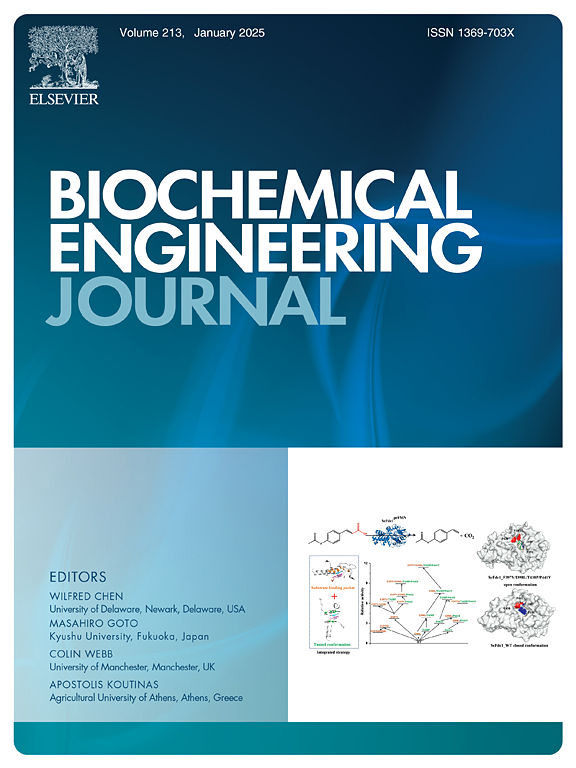Optimization of medium-high-temperature acidification of kitchen waste with response surface methodology in two-phase anaerobic digestion process
IF 3.7
3区 生物学
Q2 BIOTECHNOLOGY & APPLIED MICROBIOLOGY
引用次数: 0
Abstract
In the acid-producing phase at middle-high temperatures, the generation of soluble organics (such ethanol, acetic acid, and butyric acid) from kitchen trash was optimized. The response variable in this investigation was the fermentation of butyric acid. Temperature, food/microorganisms ratio [F/M], organic load [OL], pH, hydraulic retention time [HRT], and their interactions with the yield of butyric acid and acetic acid were examined using the response surface methodology. The ideal values of the process parameters were also identified. The results indicated that the following conditions had the greatest impact on acid production: 41.67 °C, F/M 2, beginning pH of 9, HRT of 3.35 days, and OL of 80 g volatile solids·L−1. The combined concentrations of butyric and acetic acids at these process conditions were 19324.7 mg·L−1, or 89 % of the total VFA concentration. In contrast to ultrahigh temperatures, medium-high temperatures improved acidogenic bacterial survival and produced greater system stability and acid production capability, according to a study on acidogenesis at different temperatures. Propionic acid buildup was inhibited and the substance's selectivity was improved by achieving a tailored fermentation mode dominated by butyric and acetic acids through strategic parameter optimization. The study's findings offer a theoretical framework for further investigation into two-phase anaerobic digestion systems.
响应面法优化餐厨垃圾两相厌氧消化中高温酸化工艺
在中高温产酸阶段,优化了厨余垃圾中乙醇、乙酸、丁酸等可溶性有机物的生成。本研究的响应变量为丁酸发酵。采用响应面法考察了温度、食物/微生物比(F/M)、有机负荷(OL)、pH、水力停留时间(HRT)及其与丁酸和乙酸产率的相互作用。确定了工艺参数的理想值。结果表明:41.67℃、F/ m2、起始pH为9、HRT为3.35 d、OL为80 g挥发性固体·L−1的条件对酸产量影响最大。在此工艺条件下,丁酸和乙酸的总浓度为19324.7 mg·L−1,占VFA总浓度的89 %。根据一项不同温度下的产酸研究,与超高温相比,中高温提高了产酸细菌的存活率,提高了系统的稳定性和产酸能力。通过优化发酵工艺参数,优选出以丁酸和乙酸为主的发酵模式,抑制了丙酸的生成,提高了物质的选择性。该研究结果为进一步研究两相厌氧消化系统提供了理论框架。
本文章由计算机程序翻译,如有差异,请以英文原文为准。
求助全文
约1分钟内获得全文
求助全文
来源期刊

Biochemical Engineering Journal
工程技术-工程:化工
CiteScore
7.10
自引率
5.10%
发文量
380
审稿时长
34 days
期刊介绍:
The Biochemical Engineering Journal aims to promote progress in the crucial chemical engineering aspects of the development of biological processes associated with everything from raw materials preparation to product recovery relevant to industries as diverse as medical/healthcare, industrial biotechnology, and environmental biotechnology.
The Journal welcomes full length original research papers, short communications, and review papers* in the following research fields:
Biocatalysis (enzyme or microbial) and biotransformations, including immobilized biocatalyst preparation and kinetics
Biosensors and Biodevices including biofabrication and novel fuel cell development
Bioseparations including scale-up and protein refolding/renaturation
Environmental Bioengineering including bioconversion, bioremediation, and microbial fuel cells
Bioreactor Systems including characterization, optimization and scale-up
Bioresources and Biorefinery Engineering including biomass conversion, biofuels, bioenergy, and optimization
Industrial Biotechnology including specialty chemicals, platform chemicals and neutraceuticals
Biomaterials and Tissue Engineering including bioartificial organs, cell encapsulation, and controlled release
Cell Culture Engineering (plant, animal or insect cells) including viral vectors, monoclonal antibodies, recombinant proteins, vaccines, and secondary metabolites
Cell Therapies and Stem Cells including pluripotent, mesenchymal and hematopoietic stem cells; immunotherapies; tissue-specific differentiation; and cryopreservation
Metabolic Engineering, Systems and Synthetic Biology including OMICS, bioinformatics, in silico biology, and metabolic flux analysis
Protein Engineering including enzyme engineering and directed evolution.
 求助内容:
求助内容: 应助结果提醒方式:
应助结果提醒方式:


